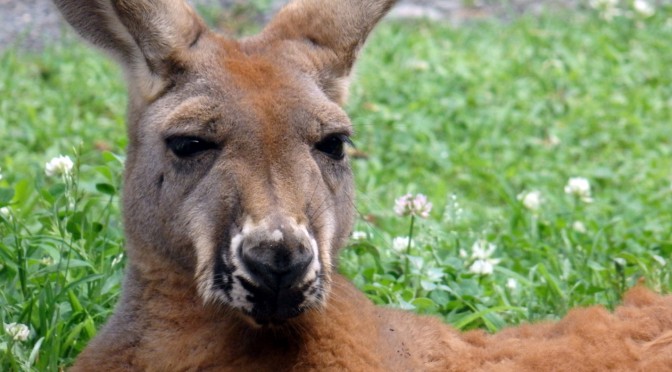NOTE: Education Animals are “behind-the-scenes” animals & only appear to the public during Educational events. This includes scheduled events or programs such as daily animal mingles, private onsite programs, and zoo reaches. For more information, please reach out to edureservations@lvzoo.org.
Program and General Information
Southern three-banded armadillos can be found in Central South America, primarily in Argentina, Brazil, Bolivia, and Paraguay. They can reach lengths up to 12-14 inches long (from nose to tip of tail) and weigh up to 3 pounds. Males are generally heavier than females. Three-banded armadillos are blackish-brown in color with yellowish white hair on the underside and are relatively small compared to other armadillo species.
Armadillos are the only mammals covered by an outer body of armor made up of bony plates and covered in keratin. Three- banded armadillos get their name from the three bands that run along the mid- section of their back armor plates, although they can have anywhere from 2-4 bands. Their primary diet consists of beetle larvae, ants, and termites, but they will also occasionally snack on ripe fruit.
Although mostly solitary, three-banded armadillos will come together during breeding season. Breeding is believed to occur between October and January. After a gestation of about four months, females give birth to a single baby. Young armadillos nurse for about two and a half months and mature between 9 and 12 months of age.
Diet
Hairs underneath their body, a strong sense of smell, and well-developed hearing allow the armadillo to detect both predator and prey. They can smell worms up to eight inches below the surface. In the wild they feed primarily on ants, beetle larvae, and termites, which they obtain using their powerful forelegs and claws. In the wet season, they also add fruit into their diet .
A three-banded armadillo uses its long, sharp front claws to dig into termite mounds to feast on the insects inside. It also uses them to break open tree bark to snack on beetle larvae hiding inside.
During the day these armadillos rest in burrows to keep cool and safe, and will come out at night to start looking for food. Instead of burrowing like other armadillos, the Southern three-banded armadillo will use an anteater’s burrow after they abandon it. They may also create dens under dense vegetation.
Habitat and Range
Southern three-banded armadillos are found primarily in dry forests and grasslands of Argentina, Bolivia, Brazil, and Paraguay. They can also be found in and around agricultural fields.
Although mainly nocturnal, armadillos may be a bit more active during the day when the weather is cooler.
Common Physical Features
Three-banded armadillos are smaller than other species of armadillos, reaching lengths of only about 12-14 inches and weighing up to 3 pounds. They are various shades of black-brown and have yellowish white hair on their underside. Males are typically larger/heavier than females. Three-banded armadillos are distinguishable by the 3 large bands that run along their midsection. While their forefeet each have four separate toes, the three central toes of their hind feet are fused together, almost like a hoof. These claws are very powerful and are used to dig to find insects.
Adaptations: The armadillo’s “armor” or carapace is made out of tough leathery skin and dermal plates (called osteoderms) which are divided into three sections: a scapular shield, a pelvic shield, and a series “bands” around the mid-section. Each band is connected by a fold of skin that allows for the bands to move apart, so the armadillo can roll into a ball. The dermal plates provide a tough yet flexible covering accounting for 16% of the armadillo’s total body weight. The armadillo’s head is also covered in keratinous scales, the same material that makes up our fingernails and hair, but their ears and underside lack any protective armor.
They have a long and tapered snout used to project their tongues in and out in order to forage for insects. Like most insect eating mammals, their tongues are very long and sticky to slurp up insects quickly. Insects are captured by digging up underground nests and/or tearing the bark off of rotting trees and turning over rotting leaf piles. The long, sharp claws on the front legs of the armadillo are
made of keratin, which makes them very strong for digging. Armadillos also have wiry hairs on their sides and bellies that act like feelers to help the armadillos sense any prey beneath them.
Unlike other armadillos who cannot completely close up into their shells, when frightened three-banded armadillos will roll up almost all the way until their armor forms a trap. The Brazilian and the Southern three banded armadillos are the only two species that can curl into a complete ball. Their tails fit alongside their heads perfectly like a yin and yang symbol The carapace is not attached to the skin on the two sides, allowing the head, legs and tail to tuck inside when the animal rolls into a ball. Rather than sealing completely shut, they often leave their armor partially open. If a predator tries to penetrate the shell to reach the soft underbelly, the armadillo can quickly snap shut on the intruder. The shell also helps protect them from the thorny vegetation that armadillos frequently pass through. Since the shell can close tight, air becomes trapped inside that is then warmed by body heat, thus keeping the armadillo warm in colder temperatures.
Behavior and Life Cycle
Three-banded armadillos are solitary creatures that prefer to spend their time alone, but when the weather is cold they have been observed gathering in groups of up to 12 individuals. They will also come together for breeding season. Not much is known about the breeding behavior of the three-banded armadillo, but it is believed that breeding season occurs between October and January.
After a gestation of about 120 days, a female will give birth to a single offspring. The infant armadillo looks like a smaller version of the adult, but has softer scutes. Babies are born blind but quickly develop the ability to walk and close their shells. Young armadillos are raised by the female only, and are
independent in just 72 days. After leaving its mother’s care, a young southern three-banded armadillo may share a home range with its mother for a short time. They will mature in 9-12 months.
There slow reproductive rate makes it challenging for the three-banded armadillo to recover from population declines.
Conservation Messaging
Conservation of the Natural World
As of 2013, three-banded armadillos have been listed as near threatened. The greatest threats facing this species are habitat destruction and hunting pressures. Given the low reproductive rate, populations that have been harvested for the meat or have been disrupted by habitat loss may take a long time to recover.
Southern three-banded armadillos are occasionally hunted by people for food, scute collecting, or the pet trade. Their defense strategy of curling into a ball makes these armadillos easy for humans to catch, meaning that humans can potentially become a major threat to southern three-banded armadillos.
What can we do?: One way you can help is by buying sustainable products. Products such as chocolate and coffee that come from the rainforest can be harvested in a more sustainable way. Instead of buying these products from sources that may be contributing to the destruction of the rainforest through destructive harvesting, look for options that help aid conservation efforts by using sustainably sourced ingredients.
By purchasing products from certified organizations such as Bird Friendly, you are helping in the conservation of forests and habitats around the world! Another way you can help is by limiting the amount of waste you accumulate. See if you can reuse something before you throw it away. If we all do this, the demand for resources found in the rainforest may decrease, helping to preserve the sloths’ one and only home. Remember: “Reduce, Reuse, Recycle!”
Along with being hunted for their shells and meat, armadillos are also captured for the illegal pet trade. Never remove an animal from the wild! Removing them from their natural environment can be detrimental to the wild populations. And while you may think they are cute, armadillos would NOT make a good pet. They have a lot of special requirements including proper nutrients, space, heating, lighting, humidity, etc. Caring for an armadillo is hard work, and the majority of people are not properly equipped to handle them.
Fun Facts
- Usually only seven of these armadillos found in a square km
- They’re closest relatives are sloths and anteaters.
- They are roughly the size of a soccer ball!
- Armadillo is a Spanish word meaning “little armored one,” referring to the bony plates that cover much of an armadillo’s body. These bony plates are made of keratin – the same protein that makes up our hair and nails!
- Of the 20 species of armadillo, this is the only one that can roll up completely in a ball.
- The male’s penis is one of the longest among mammals, extending two-thirds of the body length in some species.
- This species has less chromosomes than other species (2n = 38 compared to others: 2n = 50-64).










